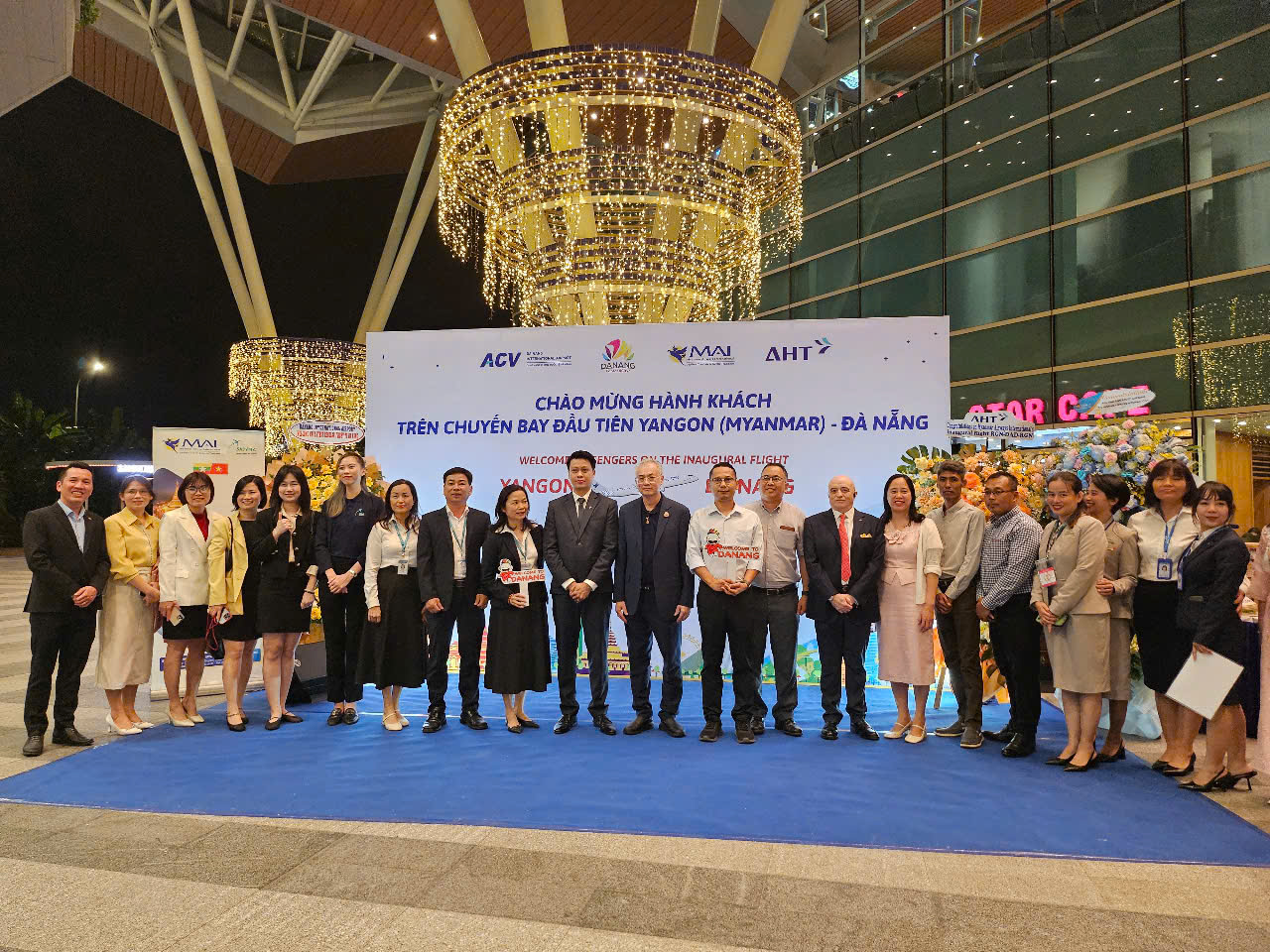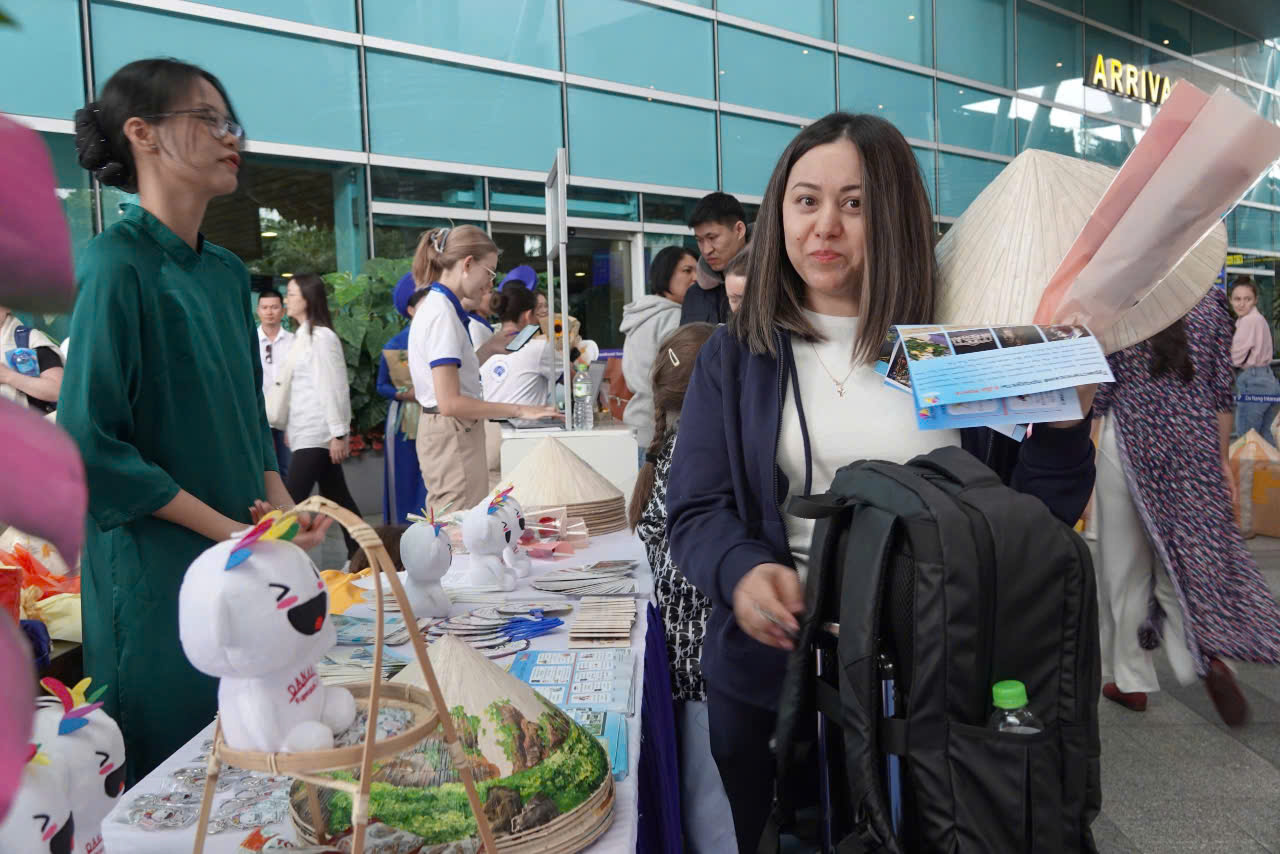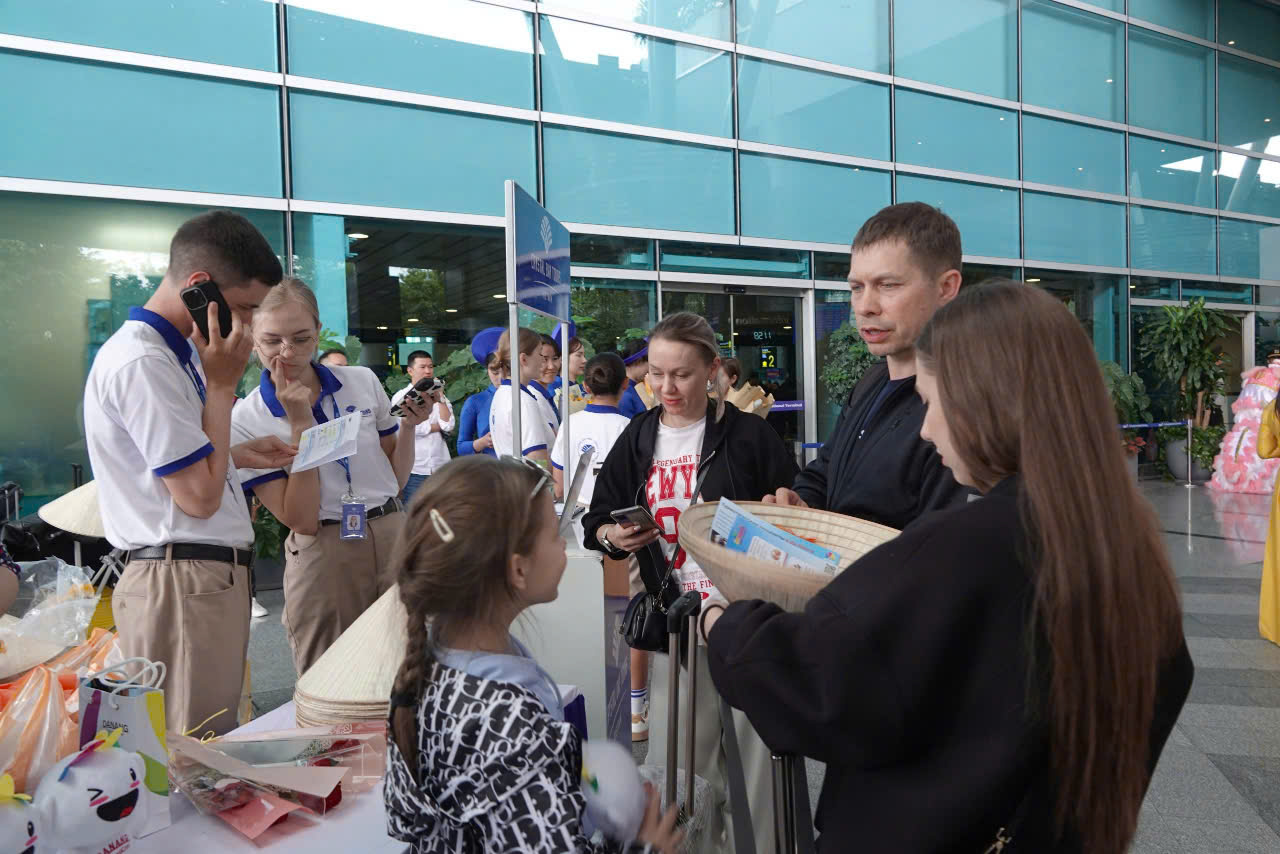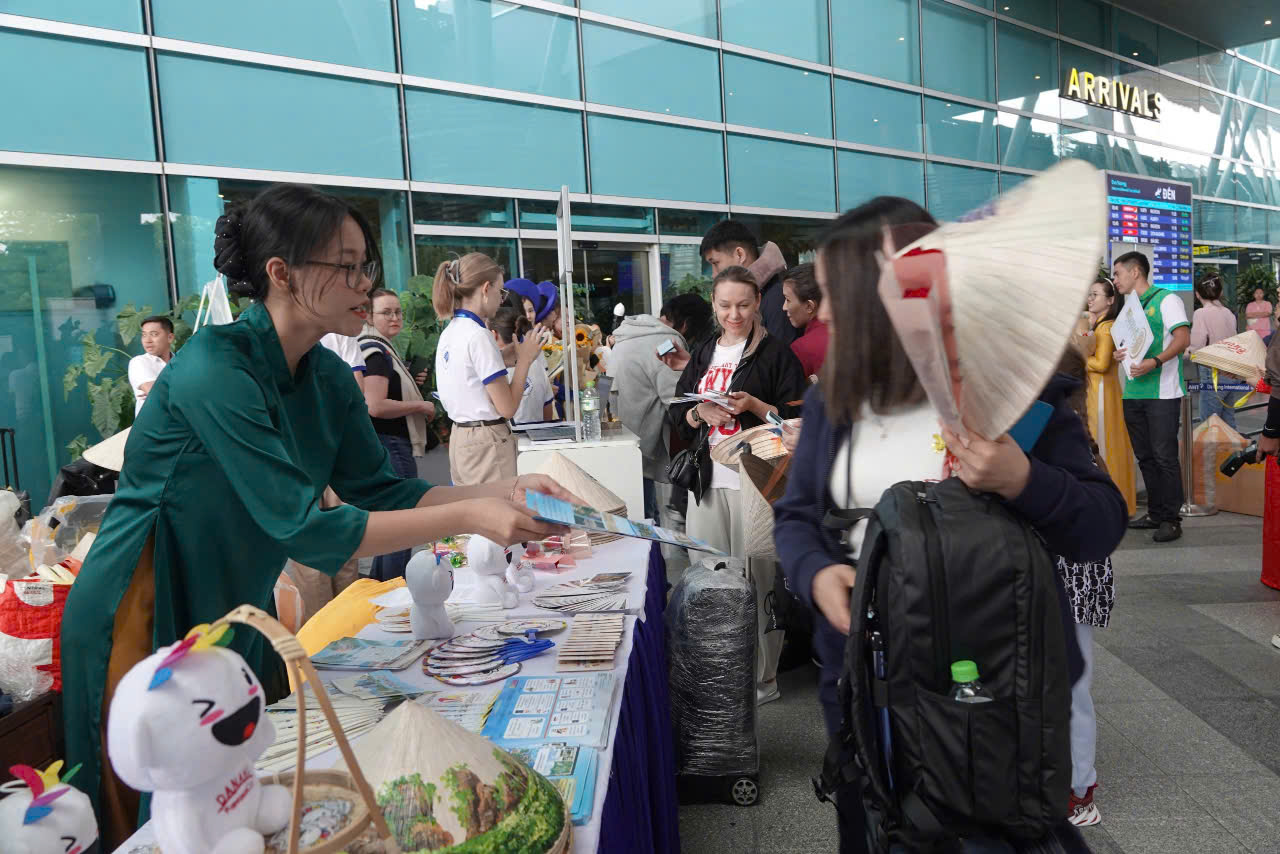On the morning of April 2, 2025, the highly anticipated flight VJ52, operated by an A330/300 aircraft, made a triumphant arrival at Da Nang International Airport from Almaty, Kazakhstan. This inaugural direct flight, which brought nearly 300 eager passengers, marks a significant step in the exploration of the diverse tourism offerings of Da Nang City.
DA NANG ESTABLISHES A DIRECT AIR LINK TO TOURISM MARKETS IN KAZAKHSTAN AND CIS COUNTRIES

A welcoming ceremony was held at the International Arrival Terminal of Da Nang International Airport to commemorate this significant milestone. The event was graced by prominent figures, including representatives from the Da Nang Department of Tourism, the Da Nang International Airport Border Gate Police, the Middle Airports Authority, and the Da Nang International Terminal Investment and Operation Joint Stock Company (AHT). Travel agency representatives, such as Crystal Bay Tour and Rustar DMC Vietnam, along with media members, attended the ceremony.
The program was a celebration of cultural diversity, featuring a traditional water salute, captivating cultural performances, a delightful presentation of welcome flowers and conical hats to all arriving passengers, and opportunities for memorable photographs. This warm welcome is just a glimpse of what awaits you in Da Nang. In alignment with future travel plans, regular direct flights from Kazakhstan to Da Nang will be scheduled at a frequency of four flights per week from April to October 2025.
Ms. Truong Thi Hong Hanh, Director of the Da Nang Department of Tourism, emphasized, “The launch of the Almaty-Da Nang route is a significant advancement in connecting Da Nang to the Kazakhstan market and the Commonwealth of Independent States (CIS). This connection is crucial in attracting tourists from this promising new source market. The Da Nang Department of Tourism has proactively developed a comprehensive Service Plan for the CIS market, ensuring a high-quality tourism experience through direct air routes, communication and marketing strategies, market research, promotional campaigns, information dissemination, market orientation, safety and security protocols, product development, and enhancement of human resources”.
ADDITIONAL INFORMATION
I. GENERAL INFORMATION ABOUT THE COMMONWEALTH OF INDEPENDENT STATES (CIS)
1. Overview: The CIS (Commonwealth of Independent States) comprises 9 official member states: Armenia, Azerbaijan, Belarus, Kazakhstan, Kyrgyzstan, Moldova, Russia, Tajikistan, and Uzbekistan.
2. Population (as of July 1, 2024):
• Armenia: approx. 3 million
• Azerbaijan: approx. 10.4 million
• Belarus: approx. 9.1 million
• Kazakhstan: approx. 20.6 million
• Kyrgyzstan: approx. 7.2 million
• Moldova: approx. 3 million
• Russia: approx. 144.9 million
• Tajikistan: approx. 10.6 million
• Uzbekistan: approx. 36.4 million
3. Income and Economy:
4. The CIS’s total GDP reached approximately USD 2.6 trillion in 2024. The region is economically significant due to its abundant natural resources, especially oil, gas, precious metals, and agricultural products.
• Russia is the largest economy in the bloc, accounting for over 60% of the region’s GDP, mainly through energy and resource exports.
• Kazakhstan has a stable, resource-based economy focused on oil, gas, and minerals.
• Belarus emphasizes industrial manufacturing and machinery.
• Azerbaijan’s economy is primarily oil- and gas-driven.
• Armenia focuses on light industry and services.
• Kyrgyzstan, Tajikistan, and Uzbekistan rely heavily on agriculture, representing lower-middle-income economies.
Travel Preferences of CIS Tourists:
• Duration and Timing: Russian-speaking tourists generally have more vacation time and prefer long holidays, especially during the winter season (December–February). Tours typically last 10–15 days.
• Booking Method: Group and family travel mostly through tour operators.
• Language: Russian is widely spoken or used in public life across the CIS.
• Religion: Islam is the predominant religion in many CIS countries, especially in Azerbaijan, Kazakhstan, Kyrgyzstan, Tajikistan, Turkmenistan, and Uzbekistan (mostly Sunni).
• Preferences: Warm tropical beaches, sunbathing, water-based recreation, sightseeing. Most CIS travelers avoid pork but enjoy alcoholic beverages at hotel bars or beachside venues, including cocktails, vodka, and beer.
II. PROPOSED PLAN TO DEVELOP AND SERVE INTERNATIONAL TOURISTS VIA DIRECT FLIGHTS FROM CIS COUNTRIES
1. Marketing, Promotion & Market Research
• Organize welcome events for inaugural flights to Da Nang.
• Promote the new routes on the official Da Nang Tourism Portal and the Department of Tourism’s social media channels.
• Publish PR articles in domestic and international media highlighting new routes and premium market potential.
• Collaborate with Air Astana and travel companies such as Crystal Bay, Rustar DMC Vietnam, Anex, etc., to promote Da Nang via their platforms.
• Work with Da Nang International Airport (DIA) and AHT to launch joint promotion campaigns targeting new markets.
• Host a welcome event for the Almaty–Da Nang inaugural flight (expected April 2, 2025)
• Conduct year-end market surveys to understand CIS traveler preferences and enhance service quality.
2. Market Stimulation Activities
• Participate in roadshows in Kazakhstan and Kazakhstan International Tourism Fair (KITF)
• Launch inbound-outbound combo tours and incentive travel packages.
• Host famtrip and press trip delegations from CIS countries
• Implement tourism stimulus campaigns to encourage repeat visits.
• Promote MICE and wedding tourism targeting the CIS market.
• Co-organize seminars on promoting Middle Eastern and CIS markets (e.g., “ANEX Travel Promotion Workshop 2025” from May 12–14, 2025)
3. Information Sharing, Market Orientation & Safety Assurance
• Organize workshops to share market insights and service strategies for CIS and Middle Eastern markets (targeting accommodations and certified service providers)
• Run training programs for tour operators, attractions, and tour guides serving these markets.
• Conduct regular field inspections to ensure service quality, safety, hygiene, and customer satisfaction.
• Strengthen beach safety measures.
• Issue directives for tour operators to promote new air routes and develop two-way travel products, and disseminate flight route information nationwide for coordinated promotion
4. Tourism Product Preparation & Customization
• Review existing tourism offerings and propose more nighttime activities for tourists.
• Develop specialized promotional materials (e.g., standout services, cuisine, Halal-certified facilities)
• Advise service providers on guest expectations and market characteristics and coordinate with Halal certification agencies and Halal food suppliers.
• Design CIS market-specific travel manuals using visual formats to support local service providers.
5. Human Resource Development
• Conduct hospitality training programs (communication skills, cultural sensitivity, culinary preferences, service standards for specific markets, etc.)
• Offer vocational language training in rare languages (e.g., Russian) for tour guides and staff at attractions.
• Collaborate with the University of Foreign Languages – University of Da Nang and other tourism/language training institutions to prepare skilled professionals who serve rare-language markets.
6. Service Quality Assurance & Development of New Offerings
• Commit to delivering high-quality tourism services; organize regular professional and language training for frontline staff.
• To boost tourism growth, actively engage in promotional activities organized by the Department of Tourism and contribute ideas for new products and services suitable for target markets.
DANANG CENTER FOR TOURISM PROMOTION


